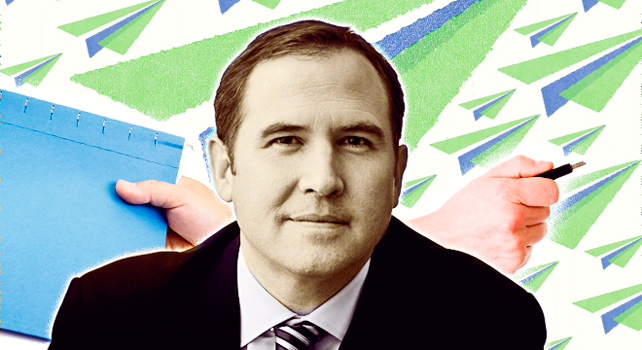With Dropbox, Box, and now Google Drive hankering to usurp YouSendIt's market leadership, newly minted CEO Brad Garlinghouse is keeping a cool head--and an eye on customers.

He’s a week into his job at YouSendIt and CEO Brad Garlinghouse doesn’t have an office yet. But he’s in no rush to claim a corner spot or a coveted windowed view at the company’s Campbell, Calif. headquarters just yet. “We have offices on three floors,” Garlinghouse explains, “So each week I am going to spend time on a different floor, getting to know everyone.”
Garlinghouse is actually applying this laid back, wait-and-see approach to taking the reins in general. Citing YouSendIt’s current market leadership --its cloud-based filed sharing and collaboration platform has gathered over 30 million registered users and 585,000 paid subscribers since its launch in 2004--he tells Fast Company he’s not stressed.
“We have a very robust product suite,” he says noting the recently launched Workstream, the B2B content collaboration tool among others released over the past year. “The wind is at our back,” he adds, “Because among ‘pro-sumers’ [professional or enterprise customers] YouSendIt is known as a good brand.”
As a veteran of both Yahoo! and more recently AOL, where Garlinghouse served as president of consumer applications and head of AOL’s Silicon Valley operations, he’s taking a moment to exhale. “When you come into a declining organization like AOL that is in turnaround mode, your tolerance and speed at making decisions is different,” he says of leading the charge to expand flagging products such as AOL Mail and AIM globally.
The Challenge: Managing Growth
At YouSendIt, Garlinghouse says, there’s a different, but equally challenging, proposition. The startup "trainwreck" is barely visible in the rear view anymore, and the company's seen 60 and 61 percent revenue growth over the last two years. “If it’s not broken you have to be careful not to fix it,” he says. Some executives may be eager to put their fingerprints all over their new company, but not him. “You want to be careful because you may end up doing harm. YouSendIt is growing very quickly and managing growth is the hardest thing.”
Growth is the reason he took the job, Garlinghouse says, rather than pursue the investor route like some other successful Silicon Valley execs (hello Reid Hoffman). A consultation with good friend Sheryl Sandberg, COO of Facebook, sealed the deal. “She said she always went with fast growth companies. They have a tendency to help hide other sins,” he says.
The Current Manifesto: Compete on Customer Outcomes, Not Cost
Not that he’s suggesting there are lots of sins to hide. But how does YouSendIt stack up to Garlinghouse’s much-talked about “peanut butter manifesto” test? “Any organization can be more focused,” he admits, referring to his 2006 memo when as then-SVP Yahoo! he called out the company for its lack of cohesive vision. “I’d give YouSendIt a B,” he adds with a chuckle.
YouSendIt’s product suite “almost by definition gets a good grade,” he says, “But we could do better with clarity of purpose and messaging. There are aspects of our external communication that I’m not proud of.” But that’s a lot easier to fix than problems with the underlying business, he says, which is not an issue he sees at YouSendIt.
Garlinghouse says he’s also going to concentrate on customer outcomes rather than, say, changing YouSendIt’s pricing structure or seeking more funding (the company’s already raised nearly $50 million). Reiterating what he said at the TC Disrupt conference this week, Garlinghouse believes big funding doesn’t always equal success. He cited a TechCrunch article about Box.net having a billion dollar valuation. “One of the first [success] metrics was the money they raised,” he says. Living through the first dotcom crash taught Garlinghouse that it’s not healthy for a company to raise as much as it can at the highest possible price. “Success is measured by customer outcomes. If you have very happy customers, the business side will take care of itself.”
The Constant Refrain: A Well-Grounded Attitude
Another thing he’s learned over the course of his career and from his entrepreneur father (and not in the halls of Harvard, where he got his MBA) is that its important to stay grounded to be a good leader. Though he’s been entrenched in Silicon Valley for years, Garlinghouse credits his removed-from-the-hype Midwestern upbringing with his ability to filter the noise that permeates Silicon Valley's tech scene. He’d rather build slowly and organically to ensure sustainable success. Likewise he goes back to his father’s advice about choosing the professor rather than the class. “It applies in business, too,” he maintains, where its more important to follow a good leader rather than “work for a hot, sexy company run by a 26-year old who doesn’t know how to manage.”
Does slow and steady win the race? It remains to be seen. Right now, though, YouSendIt has its work cut out for it. The new Google Drive is lying in wait to make a big user grab, and Box is looking to own the enterprise space, counting 82% of Fortune 500 companies as customers. And while Dropbox doesn’t say how many paying subscribers it has, it’s currently boasting 50 million users and is a year ahead in translation in French, Spanish, German and Japanese. Garlinghouse concedes this is an area where YouSendIt needs to play catch up.
Still, he remains unflappable and offers a quote from author Charles Swindoll as the mantra he’s already shared with the entire YouSendIt staff. “It goes something like: life is 10% what happens to me and 90% of how I react to it. We are in charge of our attitudes.”
DIGITAL JUICE
No comments:
Post a Comment
Thank's!